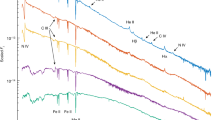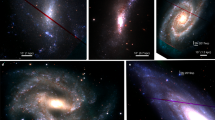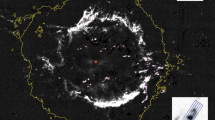Abstract
Infrared spectra of supernova 1987A taken in April and November 1987 from the Kuiper Airborne Observatory (KAO) show two distinctly different stages in the evolution of the expanding gas shell. In April both the optical and infrared spectrum originated from the hydrogen envelope, the still opaque remnant of the outer regions of the progenitor star's atmosphere. This region of the star was presumably of near solar chemical composition (although the elements heavier than helium are expected to have had an abundance from two to four times less than the Sun). Our April spectrum shows weak hydrogen lines rising above a 5,000-K photospheric continuum, in good agreement with this picture. By November, however, the spectrum of SN1987A had changed dramatically. Strong emission lines from heavy elements as well as many lines from highly excited levels of hydrogen dominated the spectrum with peak flux levels in the lines at or slightly above the level of the continuum in April. The intensity of these lines and the abundances of the heavy elements inferred from them demonstrate that the inner regions of the supernova are just now becoming visible at infrared wavelengths. These regfons are expected to contain heavy elements produced by advanced nuclear burning stages in the progenitor star (Sk–69 202) and in the shock wave that ejected all material external to the iron core. They are, of course, very deficient in hydrogen.
This is a preview of subscription content, access via your institution
Access options
Subscribe to this journal
Receive 51 print issues and online access
$199.00 per year
only $3.90 per issue
Buy this article
- Purchase on Springer Link
- Instant access to full article PDF
Prices may be subject to local taxes which are calculated during checkout
Similar content being viewed by others
References
Axelrod, T. S. in IAU Colloq. 108: Atmospheric Diagnostics of Stellar Evolution (ed. Nomoto, K.) (Reidel, Dordrecht, in the press).
Moseley, H. IAU Circ. No. 4500 (1987).
Woosley, S. E. Astrophys. J. (in the press).
Dotani, T. et al. Nature 330, 230–231 (1987).
Sunyaev, R. et al. Nature 330, 227–230 (1987).
Itoh, M., Kumagai, S., Shigeyama, T., Nomoto, K. & Nishimura, J. Nature 330, 233–235 (1987).
Pinto, P. A. & Woosley, S. E. Astrophys. J. (in the press).
Cohen, M. et al. IAU Circ. 4500 (1987).
Axelrod, T. S. thesis (Univ. California, Santa Cruz, 1980).
Axelrod, T. S. in Type I Supernovae (ed. Wheeler, J. C.) 80 (Univ. Texas, Austin, 1987).
Author information
Authors and Affiliations
Rights and permissions
About this article
Cite this article
Rank, D., Pinto, P., Woosley, S. et al. Nickel, argon and cobalt in the infrared spectrum of SN1987A: the core becomes visible. Nature 331, 505–506 (1988). https://doi.org/10.1038/331505a0
Received:
Accepted:
Issue Date:
DOI: https://doi.org/10.1038/331505a0
Comments
By submitting a comment you agree to abide by our Terms and Community Guidelines. If you find something abusive or that does not comply with our terms or guidelines please flag it as inappropriate.



